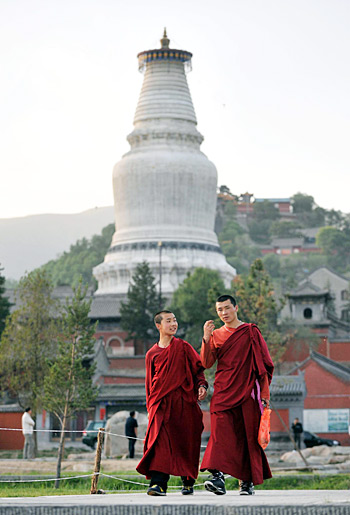|
 |
|
PIOUS PRACTICES: Around 2,000 Buddhist monks call Wutai Mountain home (CFP) |
"For a long time, the temples built on Wutai Mountain have been an important venue for religious rites," the abbot told the Beijing-based Economic Information Daily, adding that only a few temples that need to be more strictly protected do not serve as venues for religious ceremonies today.
"Wutai Mountain is a site for both Tibetan Lamaism and Chinese Buddhism, which shows the perfect mergence of cultures. The good natural environment of the site is a benefit to Buddhist study," said Zhangyang Molan, Deputy Director of the Buddhist Association of Wutai Mountain.
The Buddhist architecture on the mountain is the direct reflection of the profound Buddhist culture in the area. Cui Zhengsen, a researcher at the Shanxi Academy of Social Sciences, told Xinhua News Agency that the religious buildings on the mountain are both a comprehensive textbook on ancient architecture and a museum of it, having high value in historical, artistic and cultural research.
The most famed building is the East Hall of the Foguang Temple, or Temple of Buddha's Light, built along the slope of the mountain and embraced by green hills on three sides. It is the largest wooden building of the Tang Dynasty (618-907) surviving today with life-size clay sculptures. Another important building is the Shuxiang Temple, or Temple of Manjusri Bodhisattva's Statue, built in the Ming Dynasty (1368-1644). It features 500 large-scale arhat statues presenting Buddhist stories. The buildings on the site show the way that Buddhist architecture developed, which has influenced the palace architecture of China for more than 1,000 years.
Apart from the wooden architecture, Cui said that Wutai Mountain is also famous for its pagodas built with various materials, such as bricks, stone, wood, iron, colored glaze, copper, silver and crystal. Big pagodas normally are around 60 meters high and the smallest one is only 0.05 meter in height. According to him, the mountain boasts 150 pagodas built in different dynasties and is seen as an exhibition for China's Buddhist pagoda architectural art.
The most famous pagoda is the Big White Pagoda, which is also the symbol of Wutai Mountain. With a base circumference of 83.3 meters and a height of 75.3 meters, the pagoda is the highest Nepalese style pagoda built in the Yuan Dynasty (1271-1368) found today. The sound of the wind chimes tied on the pagoda transports people into the sacred world.
|
